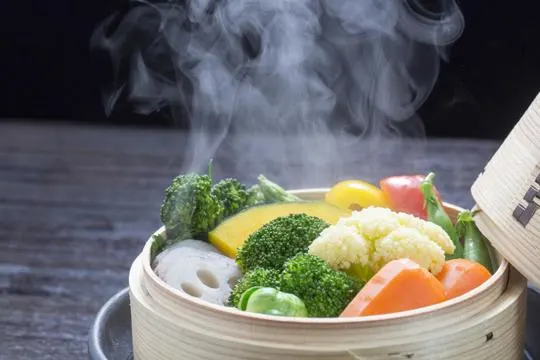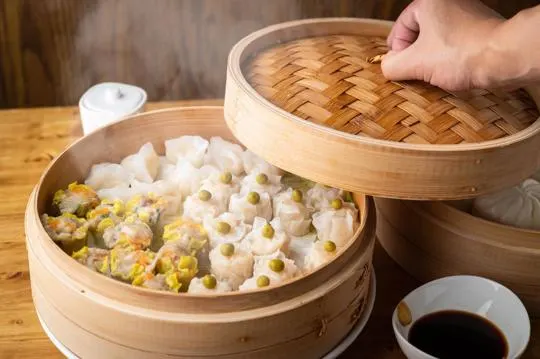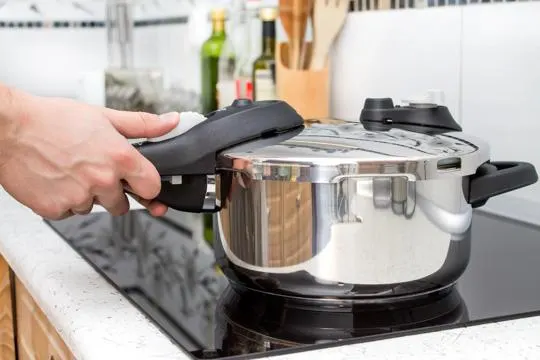Summary of key points
The distinction between Pressure Cooker and Steamer lies in their cooking methods and the results they achieve. A pressure cooker uses high pressure to cook foods quickly, retaining flavor and nutrients efficiently. A steamer cooks food with steam from boiling water, making it a healthier option by preserving more nutrients without the need for oil or fat. The choice depends on the desired cooking time and method preference.
Ever faced the kitchen dilemma of choosing between a pressure cooker and a steamer?
It’s like picking a favorite child, right? We’ve all been there.
Both gadgets promise to speed up cooking and bring out the flavors in our food. Yet, they’re as different as night and day.
I remember the time I mistook a pressure cooker for a steamer. Spoiler alert: it didn’t go well.
One uses pressurized steam to cook food fast. The other relies on gentle steam to get the job done.
Ever wondered which one suits your cooking style best?
We’re here to break it down for you, with a dash of humor and a sprinkle of personal mishaps.
Believe me, it’s a showdown worth your time.
What is a Pressure Cooker?

A pressure cooker is a great kitchen tool. It cooks food quickly and keeps flavors and nutrients.
It also tenderizes tough cuts of meat. It needs less water than traditional boiling, so vitamins and minerals stay in the food.
Pressure cookers are versatile. You can steam, braise, and bake with it.
With accessories like steamer baskets or trivets, you can turn it into a steamer for veggies, fish, or dumplings.
Safety is important too. Modern models have locking lids and a valve system.
This keeps pressure in and lets out steam. Beginners can use it safely.
So, pressure cookers save time and keep food tasty and healthy.
They are convenient for a range of recipes. Every kitchen needs one.
What is a Steamer?

A steamer? Yep, that’s a kitchen appliance.
Hot steam enters a pot or container with holes to cook the food inside.
Super nutritious and full of flavour. That’s why steamers are so popular.
They’re perfect for veggies, seafood and dumplings.
Even electric steamers make cooking easy.
So if you want to make a quick healthy meal or some yummy dim sum, a steamer is the tool you need.
Differences Between Pressure Cooker and Steamer

Pressure cookers and steamers are both cooking appliances with their own unique features.
At first glance, they appear similar, but there are some key differences.
1 – Cooking Method
Pressure cooking and steaming are two distinct ways of cooking.
Although they both involve heat, their methods vary.
Pressure cooking uses a tightly-sealed pot with a locking lid.
This creates high pressure and temperature for faster cooking.
The trapped steam infuses flavors into the food.
Steaming suspends food above boiling water and cooks the food without direct contact, preserving nutrients.
These methods differ in cooking times and abilities.
Pressure cooking can reduce cooking time by up to 70%, making it ideal for busy people who want quick meals.
It also tenderizes tough ingredients. Steaming is great for delicate foods like fish and seafood, as it prevents overcooking.
Additionally, it requires little oil, making it healthier.
Before cooking with either method, you must understand the right balance of time and temperature for optimal results.
2 – Cooking Speed
Speed of cooking? Pressure cooker wins. It cooks food fast, using high pressure and steam.
But steaming takes a bit longer. Yet, it preserves the food’s nutrients and flavors.
So if speed’s important, go for a pressure cooker.
But if nutrition is key, steaming is best.
3 – Versatility
Pressure cookers and steamers both have unique benefits, but their level of flexibility differs.
Pressure cookers are the versatile ones.
They can pressure cook, sauté, slow cook, and bake.
They’re great for making stews, meats, and more.
Steamers, on the other hand, specialize in preserving nutrition and flavor.
They’re perfect for steaming veggies, fish, and dumplings.
What sets these two apart is their adaptability.
Pressure cookers have multiple functions.
Steamers focus solely on steaming.
So if you want versatility and lots of cooking options, a pressure cooker is the way to go.
Similarities Between Pressure Cooker and Steamer

Pressure cookers and steamers may have different ways of cooking, but they share some similarities.
Both appliances help you cook food quickly and retain nutrients.
They both have a sealed lid that traps heat and pressure.
This helps food cook faster and saves energy.
Plus, both appliances use water or liquid to make steam – essential for the cooking process.
Both pressure cookers and steamers are versatile.
You can use them to make rice, vegetables, or meats.
So, they’re great for experimenting with recipes and cuisines.
It’s also important to note the differences between the two.
Pressure cookers use high-pressure steam to increase the temperature quickly.
Steamers use lower pressure to cook food while keeping its flavor and texture.
Advantages and Disadvantages of Using a Pressure Cooker
Pressure cookers have both pros and cons. On the up side, they can cut cooking time greatly.
High-pressure steam helps cook food quickly, so meals may be ready in minutes rather than hours- ideal for busy people or families.
Plus, the high pressure enhances the flavors of ingredients, making dishes tastier.
Nutrients are also preserved better than with other cooking methods, making meals healthier.
But there can be drawbacks too:
- It takes some practice to get used to the timing and settings; delicate foods can be overcooked if not monitored carefully.
- It’s not possible to check on the food while it’s cooking without first releasing the pressure, which can be inconvenient.
- Lastly, pressure cookers are usually bigger and take up more storage space.
There are also advantages.
Pressure cookers are versatile and can handle different recipes, like soups, stews, rice, and beans.
You can multitask by locking in flavors while doing other kitchen tasks.
Plus, many modern pressure cookers come with safety features such as automatic pressure release valves and locking mechanisms.
1 – Advantages
Using a pressure cooker has its perks. It reduces cooking time by up to 70%.
Plus, the sealed environment retains nutrients, vitamins, and flavors better than traditional cooking methods.
This is great for those who want healthy meals that still taste delicious.
A steamer provides its own set of advantages.
Steam instead of boiling water or direct heat preserves the texture, color, and nutrients of the food.
Steaming is especially good for veggies and seafood dishes, plus it eliminates the need for oil or fat.
When deciding between a pressure cooker or a steamer, think about individual preferences and cooking requirements.
If you’re after efficiency and time-saving features, go for a pressure cooker.
Alternatively, if you want healthier ways to cook and keep natural flavors, get a steamer.
2 – Disadvantages
The pressure cooker and steamer have pros and cons. Let’s explore their disadvantages.
- Pressure cookers need monitoring. If left alone, food can overcook or burn due to the high pressure.
- Steamers may take longer to cook than other methods.
- Both appliances need extra storage space as they are bulky.
Also, pressure cookers won’t work well with delicate foods.
Steaming may not bring the same flavor as roasting or grilling.
In conclusion, knowing the cons helps us pick the best method according to our needs and desires in the kitchen.
Advantages and Disadvantages of Using a Steamer
Steaming has its pros and cons. On the up side, it’s a healthy way to cook, retaining flavors and nutrients.
It needs little oil too, great for those watching calories.
Plus, the texture and color of ingredients remain intact. But there are drawbacks.
Steaming can take time, especially for large amounts.
It may also need more equipment than other methods.
Some food may not work well either, becoming too mushy or losing shape.
Still, steamers offer unique benefits that can’t be had with other cooking.
It’s ideal for delicate food like fish and veggies, as heat is spread evenly and they don’t get overcooked or dried out.
1 – Advantages
Pressure cooking has many advantages over steaming.
It’s much faster, tenderizes even tough cuts of meat, and preserves more nutrients.
High pressure traps steam, leading to faster cooking times.
Plus, the increased pressure makes meat moist and tender.
Studies show pressure cooking keeps more vitamins and minerals in food than steaming.
So, it’s a great pick for those wanting delicious meals with plenty of nutrition.
2 – Disadvantages
It is vital to consider the cons of each appliance when comparing pressure cookers and steamers. Let’s look at the drawbacks.
- Limited Cooking Space. Pressure cookers are smaller than steamers. This could be a problem for those who want to cook large amounts or multiple dishes.
- Longer Cooking Time. Pressure cookers take longer to reach cooking pressure, making the time longer. This could be inconvenient for those wanting quick cooking.
- Food Texture. Pressure cookers can tenderize tough cuts of meat. But, they may not be suitable for delicate foods like seafood or vegetables. The high pressure and heat can make them overcooked or lose texture.
- Safety Concerns. Pressure cookers have high pressure, which can be dangerous if misused or used wrongly. It is important to follow instructions and take safety precautions.
Despite the disadvantages, pressure cookers offer faster cooking and can keep in flavors due to the sealed environment.
Conclusion
When you compare a steamer and a pressure cooker, the key difference is in the pressure that is applied.
A pressure cooker cooks food quickly and requires very little liquid, making it a great choice for time-consuming dishes like stews or chili.
On the other hand, steaming locks in foods’ natural juices and flavors, making it better for leaner proteins such as fish or vegetables.
In addition to applying heat differently, these two kitchen tools are also extremely durable and convenient: they can be used on the stovetop (for a traditional gas flame) as well as an electric burner or an induction cooktop.
Therefore, no matter what your cooking style is, both the pressure cooker and the steamer provide valuable options for preparing delicious meals.
Whether you’re looking for a way to save time or enhance flavor profiles when preparing foods, you’ll likely find your answer with either of these invaluable appliances.

Pressure Cooker vs Steamer: What’s the Difference?
Ingredients
- Pressure Cooker
- Steamer
Instructions
- Choose between a pressure cooker and a steamer based on your cooking goals.
- Follow the specific instructions for your chosen appliance.
- Prepare your ingredients as required by your recipe.
- If using a pressure cooker, cook under pressure to save time and lock in flavors.
- If using a steamer, use gentle steam to retain nutrients and textures.
- Monitor cooking times closely for each method to achieve the desired results.
- Serve your dishes and appreciate the unique benefits of either the pressure cooker or steamer.
- Experiment with various recipes to explore the versatility of these cooking techniques.

Andrew Gray is a seasoned food writer and blogger with a wealth of experience in the restaurant and catering industries. With a passion for all things delicious, Andrew has honed his culinary expertise through his work as a personal chef and caterer.
His love for food led him to venture into food writing, where he has contributed to various online publications, sharing his knowledge and insights on the culinary world. As the proud owner of AmericasRestaurant.com, Andrew covers a wide range of topics, including recipes, restaurant reviews, product recommendations, and culinary tips.
Through his website, he aims to inspire and educate fellow food enthusiasts, offering a comprehensive resource for all things food-related.

Leave a comment